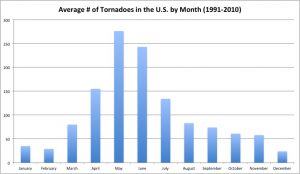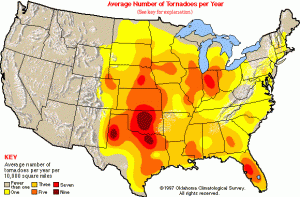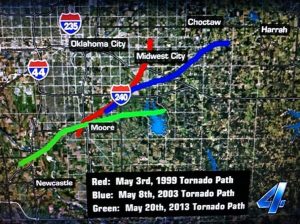- March 8, 2019
- Posted by: BlueSkies
- Categories: Climate, Extreme Weather
The deadly tornado outbreak across Alabama, Mississippi, Florida, Georgia, and South Carolina this past weekend was an abrupt and powerful announcement of the start of the 2019 tornado season. Although tornadoes can and do occur outside of the typical spring-through-summer tornado season (there have in fact been 14 tornado days since the beginning of this year), the majority of tornadoes in the United States do occur between April and July.

An outbreak of violent tornadoes (EF4 or EF5) during the first week of March may seem a bit early, but according to the Storm Prediction Center it’s happened at least 7 times since 1980. Averaged over the course of a year, tornadoes are most likely exactly where you’d expect them: in the Great Plains, with a bulls-eye over central Oklahoma and northern Texas.
However, the majority of early-season tornadoes (January – March) spin up in the Southeast, where spring arrives early. In these areas, warm, moist air from the Gulf of Mexico creeps northward, bringing a taste of spring even as the rest of the country continues to hunker down in winter parkas. But even in the Southeast, that warmth doesn’t last this time of year. Inevitably, a storm system sags southward, ushering through a cold front and a return to winter. When the arctic air behind that cold front meets the warm, moist air ahead of it, severe and sometimes tornadic thunderstorms ignite.

It is this clashing of air masses that fuels the majority of tornadic storms, and for that reason, “tornado alley” roams with the seasons.
By the time April and May roll around, people in the Southeast already have their air conditioners running and have shoved long-sleeved shirts and closed-toe shoes to the back of the closet. The meteorological action shifts north and west, towards Oklahoma, northern Texas, and Kansas – the heart of what has traditionally been labeled Tornado Alley and the birthing ground of many of the United States’ strongest and most devastating tornadoes.
In fact, the city most like to be hit by a tornado is Oklahoma City, which lies dead center in the state and has endured the impact of around 150 tornadoes since record-keeping began in 1890. The Oklahoma City metropolitan area was hit by violent EF4 and EF5 tornadoes in 1999, 2003, and 2013, with the paths of these tornadoes overlapping in several locations. The EF5 tornado that ravaged the suburb of Moore, OK on May 3, 1999 had wind speeds clocked at 318 mph – the strongest ever recorded.

The unique geography of the southern Plains gives rise to its unique and tornado-prone climatology. Wedged between the cool, dry air that spills down the leeward side of the Rocky Mountains and the warm, humid air that’s pumped northward from the Gulf of Mexico, the Great Plains fields some of the most intense and violent air mass clashes in the world.
But by June and July, even the southern Plains have been given over to summer. Storm systems shift northward and focus the tornado threat in the northern Plains and Upper Midwest. By August, as the whole country settles in to the dog days of summer, the tornado threat retreats. Hot and humid air is in place across much of the country, and storm systems are weaker.

An exception is in central Florida, where afternoon thunderstorms are a daily occurrence during the height of summer and occasionally spawn tornadoes, especially when they interact with outflow or sea breeze boundaries. The tornadoes that form under these conditions are generally weak and short-lived, however.
As summer gives way to fall, the tornado risk shifts back to the southeast, where it remains, low but present, throughout the winter.
And in the spring, like a nomad, it starts roaming again.
